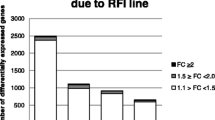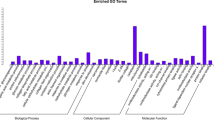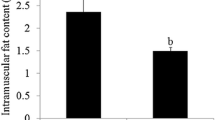Abstract
Sus scrofa provides a major source of animal protein for humans as well as being an excellent biomedical model. This study was carried out to understand, in detail, the genetic and functional variants of Jeju Native Pigs and miniature pigs through differential expression profiling of the genes controlling their immune response, growth performance, and meat quality. The Illumina HiSeq 2000 platform was used for generating 1.3 billion 90 bp paired-end reads, which were mapped to the S. scrofa genome using TopHat2. A total of 2481 and 2768 genes were differentially expressed with 8-log changes in muscle and liver samples, respectively. Five hundred forty-eight genes in muscle and 642 genes in liver samples had BLAST matches within the non-redundant database. GO process and pathway analyses showed enhanced biological processes related to the extracellular structural organization and skeletal muscle cell differentiation in muscle tissue, whereas the liver tissue shares functions related to the inflammatory response. Herein, we identify inflammatory regulatory genes in miniature pigs and growth response genes in Jeju Native Pigs, information which can provide a stronger base for the selection of breeding stock and facilitate further in vitro and in vivo studies for therapeutic purposes.









Similar content being viewed by others
Abbreviations
- AM:
-
Alveolar macrophage
- AMBP :
-
Alpha-1-microglobulin/bikunin precursor
- ACP5 :
-
Acid phosphatase 5
- COL21A1 :
-
Collagen type XXI alpha 1
- CXCL13 :
-
C-X-C Motif Chemokine Ligand 13
- DAVID:
-
Database for Annotation, Visualization and Integrated Discovery
- DEGs:
-
Differentially expressed genes
- FABPs:
-
Fatty acid-binding proteins
- FABP6 :
-
Fatty acid-binding protein 6
- FDR:
-
False discovery rate
- GO:
-
Gene ontology
- JNP:
-
Jeju Native Pig
- KEGG:
-
Kyoto encyclopedia of genes and genomes
- MyBPH :
-
Myosin binding protein H
- MARCO :
-
Macrophage receptor with collagenous
- NGS:
-
Next-generation sequencing
- NPG3 :
-
Protegrin 3
- PCA:
-
Principal component analysis
- PC:
-
Principal component
- POSTN :
-
Periostin
- PNLIP :
-
Pancreatic lipase
- PNPLA3 :
-
Patatin-like phospholipase domain-containing protein 3
- SPENCD:
-
Spondyloenchondrodysplasia
- SPENCDI:
-
SPENCD with immune dysregulation
- SVs:
-
Single variations
References
Al-Shami R, Sorensen ES, Ek-Rylander B, Andersson G, Carson DD, Farach-Carson MC (2005) Phosphorylated osteopontin promotes migration of human choriocarcinoma cells via a p70 S6 kinase-dependent pathway. J Cell Biochem 94(6):1218–1233
Amaral AJ, Ferretti L, Megens HJ, Crooijmans RP, Nie H, Ramos-Onsins SE, Perez-Enciso M, Schook LB, Groenen MA (2011) Genome-wide footprints of pig domestication and selection revealed through massive parallel sequencing of pooled DNA. PLoS One 6(4):e14782
Anders S, McCarthy DJ, Chen Y, Okoniewski M, Smyth GK, Huber W, Robinson MD (2013) Count-based differential expression analysis of RNA sequencing data using R and Bioconductor. Nat Protoc 8:1765–1786
Andrade EL, Bento AF, Cavalli J, Oliveira SK, Schwanke RC, Siqueira JM, Freitas CS, Marcon R, Calixto JB (2016) Non-clinical studies in the process of new drug development-Part II: good laboratory practice, metabolism, pharmacokinetics, safety and dose translation to clinical studies. Braz J Med Biol Res 49(12):e5646
Archibald AL, Bolund L, Churcher C, Fredholm M, Groenen MA, Harlizius B, Lee KT, Milan D, Rogers J, Rothschild MF, Uenishi H (2010) Pig genome sequence-analysis and publication strategy. BMC Genom 11(1):438
Arredouani MS, Palecanda A, Koziel H, Huang YC, Imrich A, Sulahian TH, Ning YY, Yang Z, Pikkarainen T, Sankala M, Vargas SO (2005) MARCO is the major binding receptor for unopsonized particles and bacteria on human alveolar macrophages. J Immunol 175(9):6058–6064
Badyal DK, Desai C (2014) Animal use in pharmacology education and research: the changing scenario. Indian J Pharmacol 46(3):257–265
Bazer FW, Worthington-White D, Fliss MF, Gross S (1991) Uteroferrin: a progesterone-induced hematopoietic growth factor of uterine origin. Exp Hematol 19(9):910–915
Behrens TW, Graham RR (2011) TRAPing a new gene for autoimmunity. Nat Genet 43(2):90–91
Bode G, Clausing P, Gervais F, Loegsted J, Luft J, Nogues V, Sims J (2010) The utility of the minipig as an animal model in regulatory toxicology. J Pharmacol Toxicol Methods 62(3):196–220
Briggs TA, Rice GI, Daly S, Urquhart J, Gornall H, Bader-Meunier B, Baskar K, Baskar S, Baudouin V, Beresford MW, Black GC (2011) Tartrate-resistant acid phosphatase deficiency causes a bone dysplasia with autoimmunity and a type I interferon expression signature. Nat Genet 43(2):127–131
Chaitankar V, Karakulah G, Ratnapriya R, Giuste FO, Brooks MJ, Swaroop A (2016) Next generation sequencing technology and genomewide data analysis: perspectives for retinal research. Prog Retin Eye Res 55:1–31
Chamoun Z, Vacca F, Parton RG, Gruenberg J (2013) PNPLA3/adiponutrin functions in lipid droplet formation. Biol Cell 105(5):219–233
Chen Z, Zhao TJ, Li J, Gao YS, Meng FG, Yan YB, Zhou HM (2011) Slow skeletal muscle myosin-binding protein-C (MyBPC1) mediates recruitment of muscle-type creatine kinase (CK) to myosin. Biochem J 436(2):437–445
Cho IC, Park HB, Yoo CK, Lee GJ, Lim HT, Lee JB, Jung EJ, Ko MS, Lee JH, Jeon JT (2011) QTL analysis of white blood cell, platelet and red blood cell-related traits in an F2 intercross between Landrace and Korean native pigs. Anim Genet 42(6):621–626
Conesa A, Madrigal P, Tarazona S, Gomez-Cabrero D, Cervera A, McPherson A, Szczesniak MW, Gaffney DJ, Elo LL, Zhang X, Mortazavi A (2016) A survey of best practices for RNA-seq data analysis. Genome Biol 17(1):13
Corney DC (2013) RNA-seq using next generation sequencing. Mater Methods 3:203
deLange CFM (2012) New NRC (2012) nutrient requirements of Swine. Adv Pork Product: 17-28
Dwivedi V, Manickam C, Binjawadagi B, Linhares D, Murtaugh MP, Renukaradhya GJ (2012) Evaluation of immune responses to porcine reproductive and respiratory syndrome virus in pigs during early stage of infection under farm conditions. Virol J 9(1):45
Exley MA, Hand L, O’Shea D, Lynch L (2014) Interplay between the immune system and adipose tissue in obesity. J Endocrinol 223(2):R41–R48
Frost HR, Li Z, Moore JH (2015) Principal component gene set enrichment (PCGSE). BioData Min 8(1):25
Ghadimi M, Ried T, Yfantis HG, Lee DH, Maitra A, Hanna N, Alexander HR, Hussain SP (2013) Integration of metabolomics and transcriptomics revealed a fatty acid network exerting growth inhibitory effects in human pancreatic cancer. Clin Cancer Res 19(18):4983–4993
Ghosh S, Gregory A, Smith A, Kobzik L (2011) MARCO Regulates Early Inflammatory Responses against Influenza. Am J Respir Cell Mol Biol 45(5):1036–1044
Ghosh M, Sodhi SS, Song KD, Kim JH, Mongre RK, Sharma N, Singh NK, Kim SW, Lee HK, Jeong DK (2015) Evaluation of body growth and immunity-related differentially expressed genes through deep RNA sequencing in the piglets of Jeju Native Pig and Berkshire. Anim Genet 46(3):255–264
Ghosh M, Sodhi SS, Sharma N, Mongre RK, Kim N, Singh AK, Lee SJ, Kim DC, Kim SW, Lee HK, Song KD (2016) An integrated in silico approach for functional and structural impact of non-synonymous SNPs in the MYH1 gene in Jeju Native Pigs. BMC Genet 17(1):35
Gidskehaug L, Anderssen E, Flatberg A, Alsberg BK (2007) A framework for significance analysis of gene expression data using dimension reduction methods. BMC Bioinform 8(1):346
Giraud S, Favreau F, Chatauret N, Thuillier R, Maiga S, Hauet T (2011) Contribution of large pig for renal ischemia-reperfusion and transplantation studies: the preclinical model. J Biomed Biotechnol 2011:14
Granucci F, Petralia F, Urbano M, Citterio S, Di Tota F, Santambrogio L, Ricciardi-Castagnoli P (2003) The scavenger receptor MARCO mediates cytoskeleton rearrangements in dendritic cells and microglia. Blood 102(8):2940–2947
Greaves DR, Gordon S (2009) The macrophage scavenger receptor at 30 years of age: current knowledge and future challenges. J Lipid Res 50:S282–S286
Groenen MA, Archibald AL, Uenishi H, Tuggle CK, Takeuchi Y, Rothschild MF, Rogel-Gaillard C, Park C, Milan D, Megens HJ, Li S (2012) Analyses of pig genomes provide insight into porcine demography and evolution. Nature 491(7424):393–398
Gun G, Kues WA (2014) Current progress of genetically engineered pig models for biomedical research. Biores Open Access 3(6):255–264
Gunawan A, Sahadevan S, Neuhoff C, Große-Brinkhaus C, Gad A, Frieden L, Tesfaye D, Tholen E, Looft C, Uddin MJ, Schellander K, Cinar MU (2013) RNA Deep sequencing reveals novel candidate genes and polymorphisms in boar testis and liver tissues with divergent androstenone levels. PLoS One 8(5):e63259
Gutierrez K, Dicks N, Glanzner WG, Agellon LB, Bordignon V (2015) Efficacy of the porcine species in biomedical research. Front Genet 6:293
Hahn GL (1981) Housing and management to reduce climatic impacts on livestock. J Anim Sci 52(1):175–186
Hara H, Koike N, Long C, Piluek J, Roh DS, SundarRaj N, Funderburgh JL, Mizuguchi Y, Isse K, Phelps CJ, Ball SF (2011) Initial in vitro investigation of the human immune response to corneal cells from genetically engineered pigs. Invest Ophthalmol Vis Sci 52(8):5278–5286
Hayden EC (2009) Genome sequencing: the third generation. Nature 457(7231):768–769
Jawad S, Liu B, Li Z, Katamay R, Campos M, Wei L, Sen HN, Ling D, Estrada FM, Amaral J, Chan CC (2013) The role of macrophage Class A scavenger receptors in a laser-induced murine choroidal neovascularization. Invest Ophthalmol Vis Sci 54(9):5959–5970
Joo ST, Kim GD, Hwang YH, Ryu YC (2013) Control of fresh meat quality through manipulation of muscle fiber characteristics. Meat Sci 95(4):828–836
Kamimura R, Setoyama K, Yabuki A, Tottori J, Suzuki S (2007) Characteristics and gender differences concerning pulmonary hemodynamics in Clawn miniature pigs. Exp Anim 56(5):375–378
Kayan A (2011) Identification of positional and functional candidate genes for meat and carcass quality in F2 Duroc x Pietrain resource population. Dissertation, Bonn University
Kim SW, Jung JH, Do KT, Kim KS, Do CH, Park JK, Joo YK, Kim TS, Choi BH, Kim TH, Song KD (2007) Investigation of single nucleotide polymorphisms in porcine candidate gene for growth and meat quality traits in the Berkshire breed. J Life Sci 17(12):1622–1626
Kobayashi E, Hishikawa S, Teratani T, Lefor AT (2012) The pig as a model for translational research: overview of porcine animal models at Jichi Medical University. Transpl Res 1(1):1–8
Kubistova Z, Mrazek F, Petrek M (2009) Polymorphisms of the immune response genes: selected biological, methodical and medical aspects. Biomed Papers 153(2):93–102
Kwon DN, Chang BS, Kim JH (2014) Gene expression and pathway analysis of effects of the CMAH deactivation on mouse lung, kidney and heart. PLoS One 9(9):e107559
Lan J, Lei MG, Zhang YB, Wang JH, Feng XT, Xu DQ, Gui JF, Xiong YZ (2009) Characterization of the porcine differentially expressed PDK4 gene and association with meat quality. Mol Biol Rep 36(7):2003–2010
Larson G, Liu R, Zhao X, Yuan J, Fuller D, Barton L, Dobney K, Fan Q, Gu Z, Liu XH, Luo Y (2010) Patterns of East Asian pig domestication, migration, and turnover revealed by modern and ancient DNA. PNAS 107(17):7686–7691
Lebret B (2008) Effects of feeding and rearing systems on growth, carcass composition and meat quality in pigs. Animal 2(10):1548–1558
Lefebvre V, Smits P (2005) Transcriptional control of chondrocyte fate and differentiation. Birth Defects Res Part C Embryo Today 75(3):200–212
Listrat A, Lebret B, Louveau I, Astruc T, Bonnet M, Lefaucheur L, Picard B, Bugeon J (2016) How muscle structure and composition influence meat and flesh quality? Sci World J 2016:14
Lunney JK (2007) Advances in swine biomedical model genomics. Int J Biol Sci 3(3):179–184
Pabst R, Binns RM (1994) The immune system of the respiratory tract in pigs. Vet Immunol Immunopathol 43(1–3):151–156
Padua MB, Lynch VJ, Alvarez NV, Garthwaite MA, Golos TG, Bazer FW, Kalkunte S, Sharma S, Wagner GP, Hansen PJ (2012) ACP5 (Uteroferrin): phylogeny of an ancient and conserved gene expressed in the endometrium of mammals. Biol Reprod 86(4):1–8
Patel PS, Buras ED, Balasubramanyam A (2013) The role of the immune system in obesity and insulin resistance. J Obes 2013:616193
Paudel Y, Madsen O, Megens HJ, Frantz LA, Bosse M, Crooijmans RP, Groenen MA (2015) Copy number variation in the speciation of pigs: a possible prominent role for olfactory receptors. BMC Genom 16(1):330
Peiser L, Gough PJ, Kodama T, Gordon S (2000) Macrophage class A scavenger receptor-mediated phagocytosis of Escherichia coli: role of cell heterogeneity, microbial strain, and culture conditions in vitro. Infect Immun 68(4):1953–1963
Prather RS (2013) Pig genomics for biomedicine. Nat Biotechnol 31(2):122–124
Rodgaard T, Skovgaard K, Stagsted J, Heegaard PM (2013) Cloning changes the response to obesity of innate immune factors in blood, liver, and adipose tissues in domestic pigs. Cell Reprogr 15(3):185–194
Rolfe RA, Nowlan NC, Kenny EM, Cormican P, Morris DW, Prendergast PJ, Kelly D, Murphy P (2014) Identification of mechanosensitive genes during skeletal development: alteration of genes associated with cytoskeletal rearrangement and cell signaling pathways. BMC Genom 15(1):48
Samborski A, Graf A, Krebs S, Kessler B, Bauersachs S (2013) Deep sequencing of the porcine endometrial transcriptome on day 14 of pregnancy. Biol Reprod 88(4):84–91
Sendler E, Johnson GD, Krawetz SA (2011) Local and global factors affecting RNA sequencing analysis. Anal Biochem 419(2):317–322
Simon AK, Hollander GA, McMichael A (2015) Evolution of the immune system in humans from infancy to old age. Proc R Soc B 282(1821):20143085
Smathers RL, Petersen DR (2011) The human fatty acid-binding protein family: evolutionary divergences and functions. Hum Genom 5(3):170
Sodhi SS, Park WC, Ghosh M, Kim JN, Sharma N, Shin KY, Cho IC, Ryu YC, Oh SJ, Kim SH, Song KD (2014a) Comparative transcriptomic analysis to identify differentially expressed genes in fat tissue of adult Berkshire and Jeju Native Pig using RNA-seq. Mol Biol Rep 41(9):6305–6315
Sodhi SS, Song KD, Ghosh M, Sharma N, Lee SJ, Kim JH, Kim N, Mongre RK, Adhikari P, Young KJ, Pyo HS, Sung OhJ, Jeong DK (2014b) Comparative transcriptomic analysis by RNA-seq to discern differential expression of genes in liver and longissimus dorsi muscle tissues of adult Berkshire and Jeju Native Pig. Gene 546(2):233–242
Stegle O, Teichmann SA, Marioni JC (2015) Computational and analytical challenges in single-cell transcriptomics. Nat Rev Genet 16(3):133
Swindle MM, Smith AC (2008) Swine in biomedical research. In: Conn PM (ed) Sourcebook of models for biomedical research. Humana Press, New York, pp 233–239
Walters EM, Wolf E, Whyte JJ, Mao J, Renner S, Nagashima H, Kobayashi E, Zhao J, Wells KD, Critser JK, Riley LK (2012) Completion of the swine genome will simplify the production of swine as a large animal biomedical model. BMC Med Genom 5(1):55
Waritthitham A, Lambertz C, Langholz HJ, Wicke M, Gauly M (2010) Muscle fiber characteristics and their relationship to water holding capacity of Longissimus dorsi muscle in Brahman and Charolais crossbred bulls. Asian-Austral J Anim Sci 23(5):665–671
Went PT, Zimpfer A, Pehrs AC, Sabattini E, Pileri SA, Maurer R, Terracciano L, Tzankov A, Sauter G, Dirnhofer S (2005) High specificity of combined TRAP and DBA. 44 expression for hairy cell leukemia. Am J Surg Pathol 29(4):474–478
Workman P, Aboagye EO, Balkwill F, Balmain A, Bruder G, Chaplin DJ, Double JA, Everitt J, Farningham DA, Glennie MJ, Kelland LR (2010) Guidelines for the welfare and use of animals in cancer research. Br J Cancer 102(11):1555
Xing K, Zhu F, Zhai L, Liu H, Wang Y, Wang Z, Chen S, Hou Z, Wang C (2015) Integration of transcriptome and whole genomic resequencing data to identify key genes affecting Swine fat deposition. PLoS One 10(4):e0122396
Zani IA, Stephen SL, Mughal NA, Russell D, Homer-Vanniasinkam S, Wheatcroft SB, Ponnambalam S (2015) Scavenger receptor structure and function in health and disease. Cells 4(2):178–201
Acknowledgements
This study was supported by a grant from the Next-Generation BioGreen 21 Program (No. PJ01316701; PJ01117401, and PJ0099272014), Rural Development Administration, Republic of Korea, hence the authors are thankful for this organization. Author MG also thankful to Lovely Professional University for provide necessary requirements.
Author information
Authors and Affiliations
Contributions
DKJ and MG contributed to the design the conception and designed the project; MG contributed to design, analysis, and interpretation of data; MG, NK, and JZ contributed to the collected, harvested and mRNA analyses; DCK, DH, KTD and TK contributed to collect the field samples; DKJ, KD contributed to the evaluation of intellectual contents; KKP contributed to further literature corrections; DKJ and NS contributed to revising the manuscript critically for important intellectual content; HKL and KDS contributed to the additional validation and data analysis; DKJ contributed to the final approval of the manuscript. All authors provided critical input in manuscript completion and approved the final version of the manuscript.
Corresponding author
Ethics declarations
Conflict of interest
The authors declare we have no known conflicts of interest in this work.
Ethical approval
All procedures performed in this experiment were approved by the regional Ethical Committee (Jeju National University Animal Bioethics committee permit number: 2013-0009). The animals were handled in accordance with proper animal welfare guidelines.
Informed consent
Written and intellectual contents of this article were obtained from all the authors listed in the study. All authors have been contributed to conception, design, interpretation of data and analysis.
Additional information
Handling Editor: L. Taher.
Electronic supplementary material
Below is the link to the electronic supplementary material.
Rights and permissions
About this article
Cite this article
Ghosh, M., Sharma, N., Gera, M. et al. The first comprehensive description of the expression profile of genes involved in differential body growth and the immune system of the Jeju Native Pig and miniature pig. Amino Acids 51, 495–511 (2019). https://doi.org/10.1007/s00726-018-2685-5
Received:
Accepted:
Published:
Issue Date:
DOI: https://doi.org/10.1007/s00726-018-2685-5




